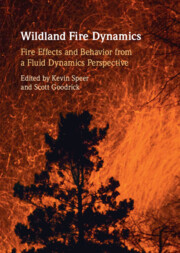Book contents
- Wildland Fire Dynamics
- Wildland Fire Dynamics
- Copyright page
- Contents
- Contributors
- 1 Wildland Fire Combustion Dynamics
- 2 The Structure of Line Fires at Flame Scale
- 3 Energy Transport and Measurements in Wildland and Prescribed Fires
- 4 Fire Line Geometry and Pyroconvective Dynamics
- 5 Firebrands
- 6 Re-envisioning Fire and Vegetation Feedbacks
- 7 Wind and Canopies
- 8 Coupled Fire–Atmosphere Model Evaluation and Challenges
- Index
- References
5 - Firebrands
Published online by Cambridge University Press: 16 June 2022
- Wildland Fire Dynamics
- Wildland Fire Dynamics
- Copyright page
- Contents
- Contributors
- 1 Wildland Fire Combustion Dynamics
- 2 The Structure of Line Fires at Flame Scale
- 3 Energy Transport and Measurements in Wildland and Prescribed Fires
- 4 Fire Line Geometry and Pyroconvective Dynamics
- 5 Firebrands
- 6 Re-envisioning Fire and Vegetation Feedbacks
- 7 Wind and Canopies
- 8 Coupled Fire–Atmosphere Model Evaluation and Challenges
- Index
- References
Summary
This chapter reviews the current state of knowledge on steps in the process of generating a spot fire. Firebrand formation and data on the size and shape of firebrands generated from wildfires are described. Various elements of firebrand lofting and transport modeling, including firebrand aerodynamics, the fire plume characteristics, models for the ambient wind field, model coupling, experimental results, and a discussion on the sensitivity of the model predictions to the inevitable uncertainty in the model input parameters, are examined. Recent work on the physics of firebrand deposition and spot fire generation is noted.
Information
- Type
- Chapter
- Information
- Wildland Fire DynamicsFire Effects and Behavior from a Fluid Dynamics Perspective, pp. 129 - 155Publisher: Cambridge University PressPrint publication year: 2022
